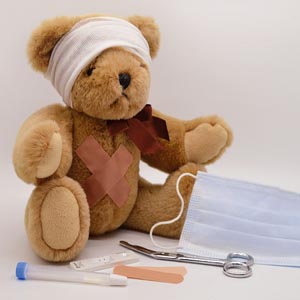Thyroid storm without precipitating factors in a previous healthy child: A case report

Accepted: 11 January 2022
All claims expressed in this article are solely those of the authors and do not necessarily represent those of their affiliated organizations, or those of the publisher, the editors and the reviewers. Any product that may be evaluated in this article or claim that may be made by its manufacturer is not guaranteed or endorsed by the publisher.
The Thyroid Storm (TS) is the severest form of thyrotoxicosis and is associated with a high mortality rate. TS presents with fever, tachycardia, gastrointestinal symptoms, and central nervous system dysfunction and may be overlooked if patients do not present thyrotoxic symptoms or have precipitating factors. We reported a pediatric case of TS with mild proptosis but no obvious precipitating factors in a previously healthy child. A 9-year-old, female patient with a history of attention-deficit hyperactivity disorder presented with the complaint of frequent vomiting. She was alert but lethargic with fever and tachycardia. Physical examination was unremarkable except for coolness in the extremities and a delayed capillary refill time of two seconds. Fluid resuscitation was ineffective in alleviating the tachycardia. Additional history-taking revealed a one-month history of mild proptosis but no other thyrotoxic findings or precipitating factors were found. Markedly elevated thyroxine and triiodothyronine and suppressed thyroid-stimulating hormone on thyroid function tests led to a diagnosis of TS. Methimazole, potassium iodine, bisoprolol, and hydrocortisone were administered. Her vital signs and thyroid functions gradually improved, and she was discharged 18 days after admission without any serious complications. She is currently euthyroid and clinically stable on 5 mg of methimazole at three months after admission. When tachycardia that is resistant to usual resuscitation is found, careful history-taking and physical examination targeting thyroid disorders should be performed to assess for TS.
Williamson S, Greene SA. Incidence of thyrotoxicosis in childhood: a national population based study in the UK and Ireland. Clin Endocrinol (Oxf) 2010;72:358-63. DOI: https://doi.org/10.1111/j.1365-2265.2009.03717.x
Chiha M, Samarasinghe S, Kabaker AS. Thyroid storm: an updated review. J Intensive Care Med 2015;30:131-40. DOI: https://doi.org/10.1177/0885066613498053
Fleisher GR, Ludwig S, Bachur RG, et al. Textbook of pediatric emergency medicine. Philadelphia: Wolters Kluwer/Lippincott Williams & Wilkins Health 2015.
Topjian AA, Raymond TT, Atkins D, et al. Part 4: Pediatric Basic and Advanced Life Support 2020 American Heart Association Guidelines for Cardiopulmonary Resuscitation and Emergency Cardiovascular Care. Circulation 2020;142:S469-S523. DOI: https://doi.org/10.1161/CIR.0000000000000918
Kornelius E, Chang KL, Yang YS, et al. Epidemiology and factors associated with mortality of thyroid storm in Taiwan: a nationwide population-based study. Intern Emerg Med 2021;16:601-07. DOI: https://doi.org/10.1007/s11739-020-02445-6
Albert BB, Eckersley LG, Skinner JR, et al. QT prolongation in a child with thyroid storm. BMJ Case Rep 2014;2014:bcr2013202595. DOI: https://doi.org/10.1136/bcr-2013-202595
Bonfield A, Shenoy S. Thyrotoxic crisis as an acute clinical presentation in a child. BMJ Case Rep 2018;2018:bcr2017222850. DOI: https://doi.org/10.1136/bcr-2017-222850
Chantra M, Limsuwan A, Mahachoklertwattana P. Low cardiac output thyroid storm in a girl with Graves’ disease. Pediatr Int 2016;58:1080-83. DOI: https://doi.org/10.1111/ped.13102
Creo AL, Cannon BC, Pittock ST. Thyroid storm after choking. J Pediatr Endocrinol Metab 2018;31:933-36. DOI: https://doi.org/10.1515/jpem-2018-0072
Dahl IL. Thyroid crisis in a 3-year-old girl. Acta Paediatr Scand 1968;57:55-8. DOI: https://doi.org/10.1111/j.1651-2227.1968.tb07286.x
Darby CP. Three episodes of spontaneous thyroid storm occurring in a nine-year-old child. Pediatrics 1962;30:927-31. DOI: https://doi.org/10.1542/peds.30.6.927
Galaburda M, Rosman NP, Haddow JE. Thyroid storm in an 11-year-old boy managed by propranolol. Pediatrics 1974;53:920-2. DOI: https://doi.org/10.1542/peds.53.6.920
Grossman A, Waldstein SS. Apathetic thyroid storm in a 10-year-old child. Pediatrics 1961;28:447-51. DOI: https://doi.org/10.1542/peds.28.3.447
Hecht T, Brand J, Vlaho S. Encephalopathy and sinustachycardia in childhood--a possible differential diagnosis. J Pediatr Endocrinol Metab 2012;25:149-51. DOI: https://doi.org/10.1515/jpem-2011-0436
Ladd JM, Sabsabi B, von Oettingen JE. Thyroid Storm in a Toddler Presenting as a Febrile Seizure. Pediatrics 2020;145:e20191920. DOI: https://doi.org/10.1542/peds.2019-1920
Landgraf L, Grubina R, Chinsky J. Altered mental status in a 16-year-old girl: the calm before the storm. Clinical Pediatrics 2008;47:720-4. DOI: https://doi.org/10.1177/0009922808315221
Lawless ST, Reeves G, Bowen JR. The development of thyroid storm in a child with McCune-Albright syndrome after orthopedic surgery. Am J Dis Child 1992;146:1099-102. DOI: https://doi.org/10.1001/archpedi.1992.02160210101033
Matsubara K, Kuki I, Yamamoto N, et al. Thyroid crisis mimicking clinically mild encephalitis/encephalopathy with a reversible splenial lesion: A pediatric case report. Brain Dev 2021;43:596-600. DOI: https://doi.org/10.1016/j.braindev.2020.12.007
Sato H, Minamitani K, Minagawa M, et al. Clinical features at diagnosis and responses to antithyroid drugs in younger children with Graves’ disease compared with adolescent patients. J Pediatr Endocrinol Metab 2014;27:677-83. DOI: https://doi.org/10.1515/jpem-2013-0288
Goldstein SM, Katowitz WR, Moshang T, et al. Pediatric thyroid-associated orbitopathy: the Children’s Hospital of Philadelphia experience and literature review. Thyroid 2008;18:997-9. DOI: https://doi.org/10.1089/thy.2008.0014
PAGEPress has chosen to apply the Creative Commons Attribution NonCommercial 4.0 International License (CC BY-NC 4.0) to all manuscripts to be published.


 https://doi.org/10.4081/ecj.2022.10165
https://doi.org/10.4081/ecj.2022.10165







